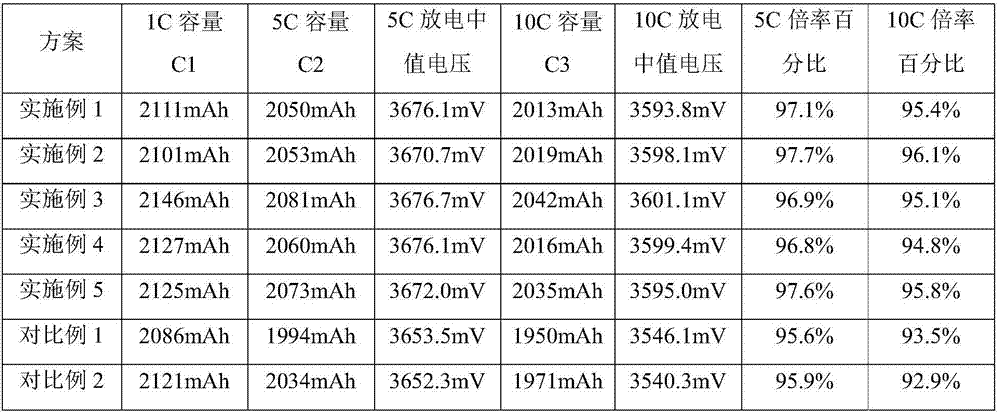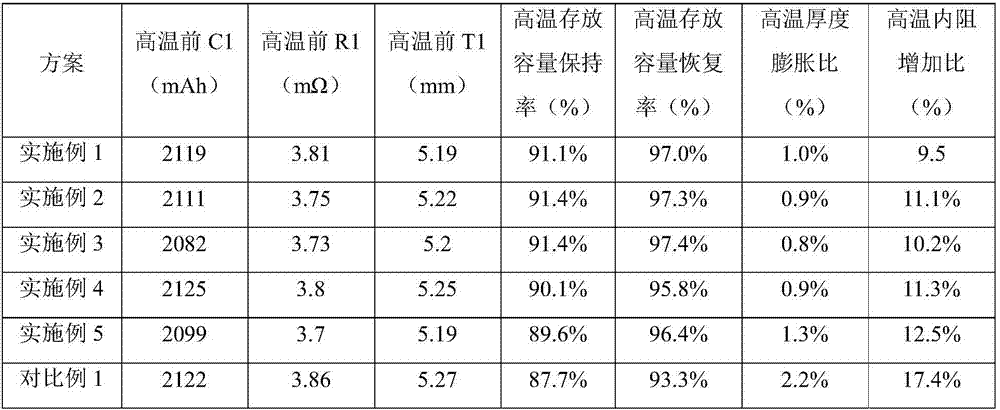Lithium ion battery electrolyte and lithium ion battery
A technology of lithium ion battery and electrolyte, applied in the field of lithium ion battery electrolyte and lithium ion battery, can solve the problems of deterioration of stability, destruction of positive electrode material, deterioration of cycle and storage performance, etc. The effect of high voltage
- Summary
- Abstract
- Description
- Claims
- Application Information
AI Technical Summary
Problems solved by technology
Method used
Image
Examples
Embodiment 1
[0038] 1. Electrolyte preparation:
[0039] In an inert gas environment with moisture <5ppm, mix ethylene carbonate, propylene carbonate, ethyl propionate, and propyl propionate uniformly in a weight percentage of 30:15:20:35. Then, lithium hexafluorophosphate is added, and the mass concentration of lithium hexafluorophosphate in the electrolyte is 14%. Then add functional additives: adiponitrile (ADN) as a positive electrode protection additive, 1,3-propane sultone (PS) and fluoroethylene carbonate (FEC) as a film-forming additive. Wherein the addition of adiponitrile is 1% of the total mass of the electrolyte, the addition of 1,3-propane sultone is 3% of the total mass of the electrolyte, and the addition of fluoroethylene carbonate is 1% of the total mass of the electrolyte. 5%. Finally, vinyl sulfate (DTD) was added as a low-impedance additive in an amount of 0.5% of the total mass of the electrolyte. After stirring evenly, an electrolyte sample was obtained.
[0040] ...
Embodiment 2
[0062] Basically the same as Example 1, the difference is that the weight ratio between ethylene carbonate, propylene carbonate, ethyl propionate, and propyl propionate in the solvent is 30:10:20:40, and the consumption of organic solvent According to the change in the amount of functional additives, the corresponding increase or decrease, the additives and the amount of adiponitrile added to account for 2% of the total mass of the electrolyte, the amount of 1,3-propane sultone added to account for 2% of the total mass of the electrolyte %, the addition of vinylene carbonate is 2.5% of the total mass of the electrolyte, and the addition of vinyl sulfate is 1% of the total mass of the electrolyte.
Embodiment 3
[0064] Basically the same as Example 1, the difference is that the weight ratio between ethylene carbonate, propylene carbonate, ethyl propionate, and diethyl carbonate in the solvent is 30:15:20:35, and the consumption of organic solvent According to the change of the amount of functional additives, the amount of adiponitrile added is 2% of the total mass of the electrolyte, and the amount of 1,3-propane sultone is 2.5% of the total mass of the electrolyte. The amount of ethylene carbonate added is 4% of the total mass of the electrolyte, and the amount of vinyl sulfate added is 1% of the total mass of the electrolyte.
PUM
 Login to View More
Login to View More Abstract
Description
Claims
Application Information
 Login to View More
Login to View More - R&D
- Intellectual Property
- Life Sciences
- Materials
- Tech Scout
- Unparalleled Data Quality
- Higher Quality Content
- 60% Fewer Hallucinations
Browse by: Latest US Patents, China's latest patents, Technical Efficacy Thesaurus, Application Domain, Technology Topic, Popular Technical Reports.
© 2025 PatSnap. All rights reserved.Legal|Privacy policy|Modern Slavery Act Transparency Statement|Sitemap|About US| Contact US: help@patsnap.com



